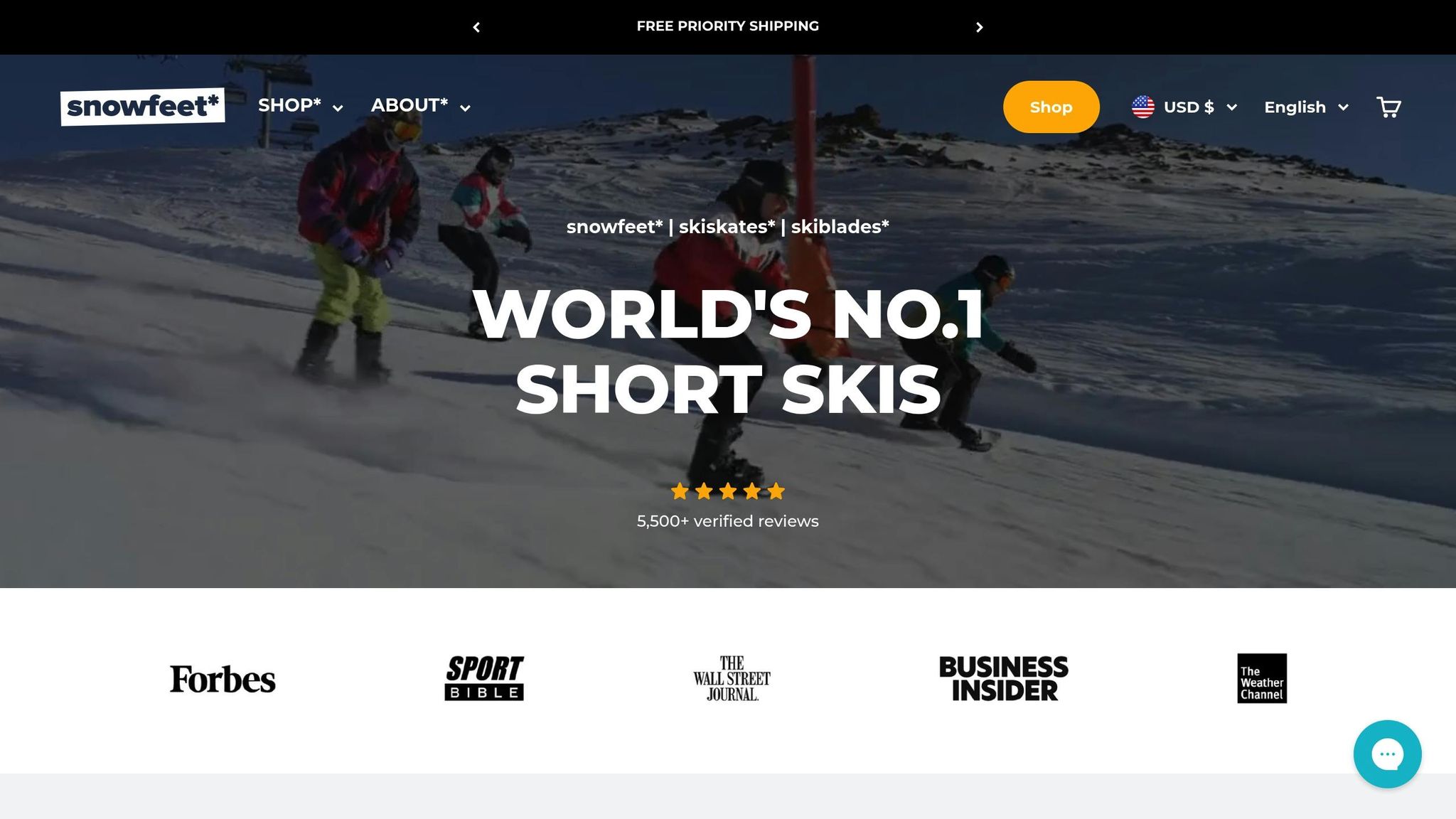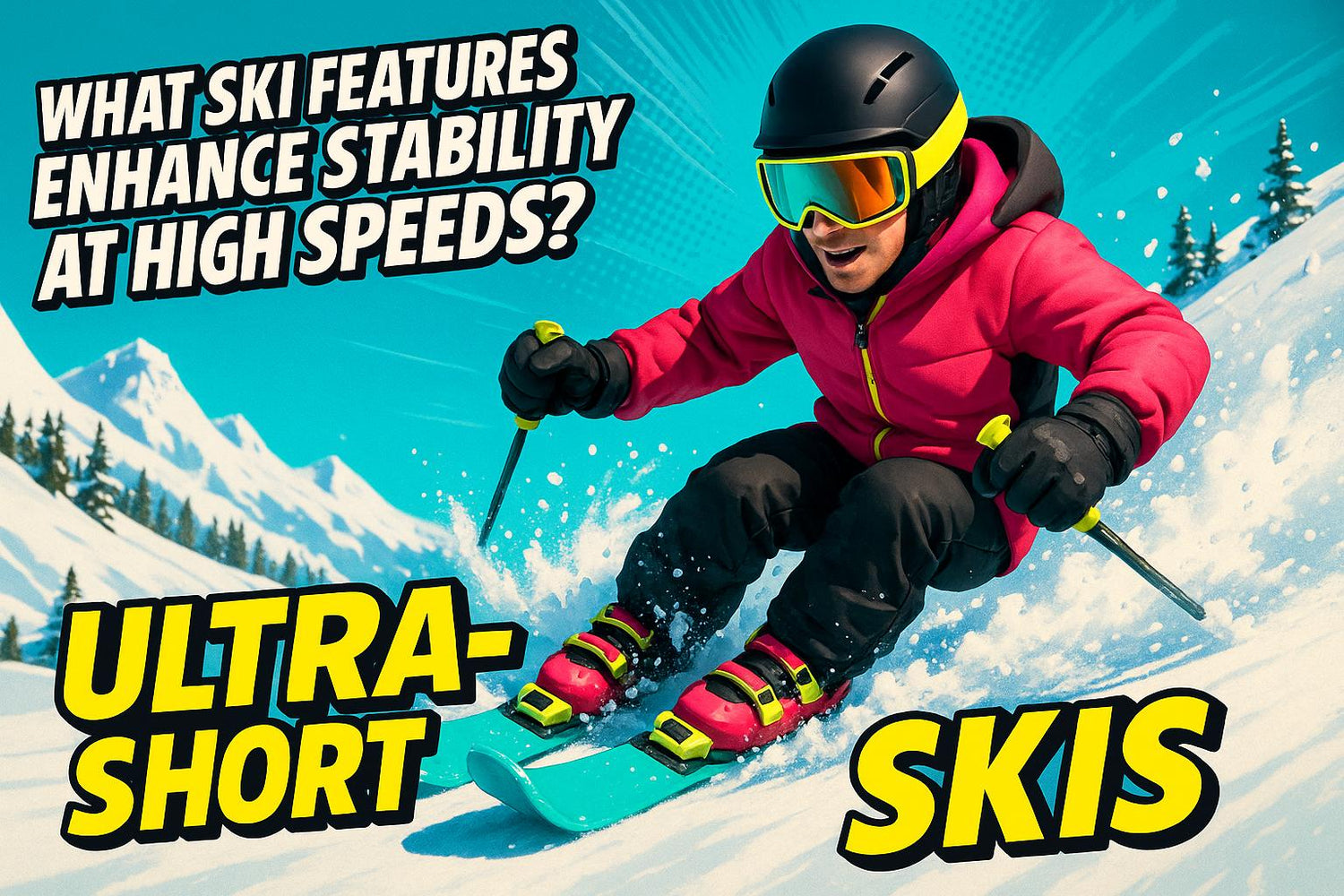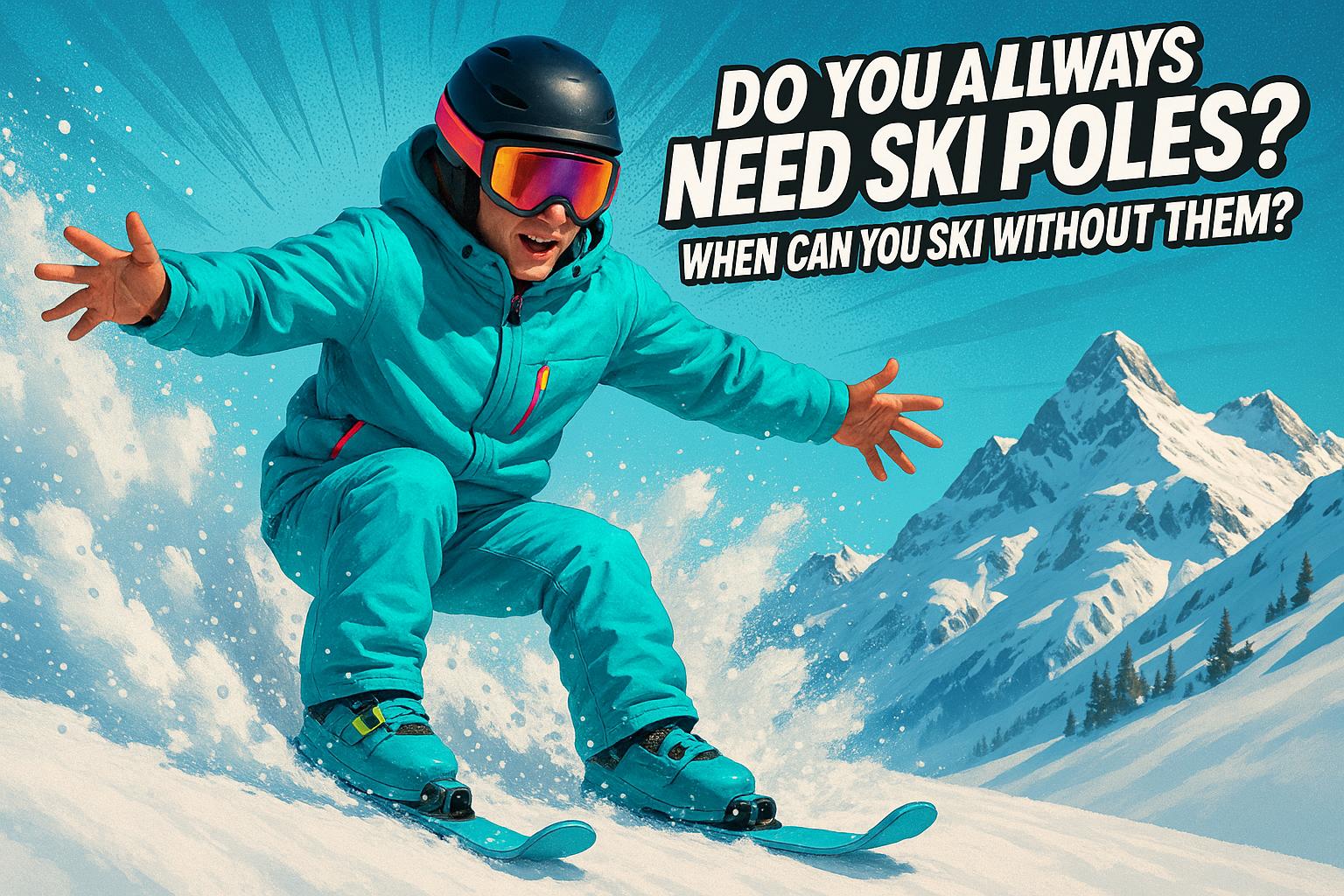Wenn es darum geht, schnell Ski zu fahren, ist Stabilität entscheidend. Aber hier ist die Sache: Lange Skier sind nicht mehr deine einzige Option. Snowfeet* bringt mit kürzeren Skiern und Skiblades frischen Wind, die Kontrolle und Agilität ohne das Volumen bieten. Hier eine kurze Übersicht:
- Snowfeet* Skiblades (99 cm): Kompakt, agil und perfekt für schnelle, scharfe Kurven. Mit 490 $ sind sie ideal für Anfänger oder Skifahrer, die eine verspielte Fahrt suchen.
- Snowfeet* Short Skis (120 cm): Eine ausgewogene Option für Geschwindigkeit und Kontrolle. Mit 690 $ sind sie ideal für präparierte Pisten und leicht zu transportieren.
- Lange Skier (170–190 cm): Die klassische Wahl für hohe Stabilität bei hoher Geschwindigkeit auf weiten Pisten, aber sie können sich schwer, weniger wendig anfühlen und kosten zwischen 400 $ und 1.200 $.
Kürzere Skier sind leichter, einfacher zu handhaben und weniger aufwendig in Wartung und Transport. Lange Skier dominieren weiterhin bei der Geradlinigkeit und Geschwindigkeit, können aber in engen Passagen oder auf vollen Pisten schwer zu manövrieren sein. Egal, ob du neu im Skifahren bist oder etwas Wendigeres suchst – kürzere Skier könnten deine Art, den Berg zu erobern, verändern.
3 Arten von Ski für 3 Arten von Skifahrern
1. Snowfeet* Skiblades (99 cm)

Die Snowfeet* 99 cm Skiblades stehen ganz im Zeichen von Geschwindigkeit und Kontrolle. Mit nur 99 cm Länge sind sie gebaut, um steile Hänge mit Selbstvertrauen zu meistern und bieten unglaubliche Stabilität, selbst wenn du an deine Grenzen gehst. Die kurze Größe ermöglicht schnelle Kantwechsel, sodass du bei scharfen, aggressiven Kurven die Kontrolle behältst.
Diese Skiblades sind mit einem niedrigeren Schwerpunkt und ausgewogener Gewichtsverteilung konzipiert, was das Einleiten von Kurven bei hohen Geschwindigkeiten erleichtert. Im Gegensatz zu traditionellen langen Skiern konzentriert sich Snowfeet* darauf, dir Agilität und Präzision in einem kompakten Paket zu bieten. Perfekt für alle, die den Nervenkitzel schnellen, reaktionsschnellen Skifahrens lieben.
Mit einem Preis von 490 $ vereinen sie modernstes Design in einem kleinen Rahmen und geben dir die Werkzeuge, um den Berg mit Geschwindigkeit und Präzision zu erobern.
2. Snowfeet* Short Skis (120 cm)
Die Snowfeet* 120 cm Short Skis sind der perfekte Mittelweg zwischen kompakten Skiblades und traditionellen langen Skiern. Mit einer Länge von etwa 47 Zoll vereinen sie Geschwindigkeit, Stabilität und Wendigkeit in einem schlanken Paket. Dieses Design bietet eine einzigartige Mischung aus Kontrolle und Agilität und macht sie zu einer herausragenden Option für Skifahrer.
In Anlehnung an die Wendigkeit der 99 cm Skiblades von Snowfeet* setzt die 120 cm Version mit Fokus auf Hochgeschwindigkeitsleistung noch einen drauf. Der etwas längere Rahmen sorgt für soliden Kontakt mit dem Schnee und gibt dir die Möglichkeit, selbstbewusst zu carven und gleichzeitig schnelle, scharfe Kurven zu fahren. Im Gegensatz zu den längeren 170–190 cm Skiern von Marken wie Rossignol oder K2, die oft breite, weite Schwünge verlangen, halten diese kurzen Ski die Sache eng und reaktionsschnell.
Mit einem Preis von 690 $ stellen sie die Vorstellung in Frage, dass längere Ski immer besser sind. Während Marken wie Salomon und Atomic stark auf längere Designs für fortgeschrittene Skifahrer setzen, beweist Snowfeet*, dass kürzere, gut konstruierte Ski Geschwindigkeit und Kontrolle liefern können, ohne den hohen Preis vieler High-End-Modelle.
Für diejenigen, die an das Volumen langer Ski gewöhnt sind, bieten diese kurzen Ski eine erfrischende Abwechslung. Sie ermöglichen eine unmittelbare, fast instinktive Verbindung zum Berg und lassen dich einen direkten und aufregenden Weg die Pisten hinunter carving.
3. Traditionelle lange Ski (170–190 cm)
Traditionelle lange Ski, die typischerweise 67 bis 75 Zoll messen, sind seit Jahrzehnten ein fester Bestandteil des Skisports. Marken wie Rossignol, K2, Salomon und Atomic haben ihren Ruf auf diesen Designs aufgebaut und versprechen dank ihrer Größe und Gewichtsverteilung bessere Stabilität und Geschwindigkeit.
Die Idee hinter langen Skiern ist ziemlich einfach: mehr Kantenkontakt mit dem Schnee. Dieser zusätzliche Kontakt kann den Grip und die Stabilität verbessern, besonders auf steileren Hängen. Mit einem Gewicht von etwa 8 bis 12 Pfund pro Paar hilft ihr Gewicht, die Geschwindigkeit zu halten, sobald du in Fahrt bist. Die längere Länge verteilt außerdem dein Gewicht, was beruhigend wirken kann, wenn du breite, offene Abfahrten meisterst.
Aber wenn es um Hochgeschwindigkeitsleistung geht, gibt es einen Haken. Während lange Ski auf präparierten Pisten mit großen, weiten Schwüngen glänzen, können sie sich unhandlich anfühlen, wenn schnelle Anpassungen nötig sind. Diese zusätzliche Länge erhöht das Trägheitsmoment, was es erschwert, scharfe oder schnelle Kurven zu fahren. Wenn du plötzlich auf eine Eisfläche triffst oder einem Hindernis ausweichen musst, können diese zusätzlichen Zentimeter gegen dich arbeiten.
Kostentechnisch liegen traditionelle lange Ski zwischen 400 und 1.200 US-Dollar. Spitzenmodelle von Marken wie Atomic und Salomon kosten oft mehr als 800 US-Dollar. Und vergessen Sie nicht, dass Sie auch Bindungen, Stiefel und Stöcke benötigen, was Ihre Gesamtinvestition leicht noch weiter erhöhen kann. Für viele entspricht der Preis nicht immer den Leistungsvorteilen, besonders im Vergleich zu neueren, vielseitigeren Skidesigns.
Der Umgang mit diesen Ski kann auch schwierig sein, besonders für Anfänger. Sie erfordern präzise Technik und können sich auf überfüllten Pisten oder in engen Bereichen, wie Waldabfahrten, einschränkend anfühlen. Ihr großer Kurvenradius bedeutet, dass Sie viel Platz zum Manövrieren benötigen, was nicht immer praktisch ist.
Während moderne Materialien wie Carbonfaser und fortschrittliche Dämpfungssysteme traditionelle lange Ski verbessert haben, besteht weiterhin ein Kernproblem: länger bedeutet nicht immer bessere Kontrolle.
Die Wartung ist ein weiterer Faktor, den man berücksichtigen sollte. Längere Ski bedeuten mehr Kante zum Abstimmen und Wachsen, was Zeit und Kosten für die Pflege erhöht. Transport und Lagerung können ebenfalls problematisch sein, da viele Skiträger und Taschen nicht für die volle Länge ausgelegt sind. Im Gegensatz zu den kompakten und wendigen Designs von Snowfeet* können traditionelle lange Ski sowohl auf als auch abseits der Piste als lästig empfunden werden.
sbb-itb-17ade95
Vor- und Nachteile
Lassen Sie uns die wichtigsten Unterschiede zwischen diesen Skitypen aufschlüsseln, besonders in Bezug auf Hochgeschwindigkeitsstabilität und Gesamtleistung. Hier ist ein schneller Vergleich:
| Merkmal | Snowfeet* Skiblades (99 cm) | Snowfeet* Short Skis (120 cm) | Traditionelle lange Ski (170–190 cm) |
|---|---|---|---|
| Länge | 39 Zoll | 47 Zoll | 67–75 Zoll |
| Kantenhalt | Metallkanten mit modernem Design | Metallkanten für ausgewogene Kontrolle | Starker Sidecut; exzellenter Grip |
| Flex | Mäßig für verspielte Kurven | Ausgewogen für sanfte Abfahrten | Steif für maximale Stabilität |
| Portabilität | Passt problemlos in den Kofferraum | Kompakt und leicht zu verstauen | Sperrig; benötigt Dachträger |
| Geschwindigkeitsstabilität | Am besten für moderate Geschwindigkeiten | Stabil bei höheren Geschwindigkeiten auf präparierten Pisten | Hervorragende Stabilität bei hohen Geschwindigkeiten |
| Ermüdungsgrad | Geringer Kraftaufwand erforderlich | Minimale Belastung für den Körper | Mit der Zeit anspruchsvoller |
Snowfeet* Skiblades (99 cm)
Diese stehen ganz im Zeichen von Agilität. Ihre kurze Länge von 39 Zoll und der moderate Flex ermöglichen schnelle, scharfe Kurven, fast wie Rollschuhlaufen auf Schnee. Sie sind auch super kompakt – perfekt, um sie ohne Aufwand in den Kofferraum zu werfen, ganz ohne Dachträger oder zusätzlichen Stauraum. Wenn du etwas Spielerisches und Einfaches suchst, könnten diese genau dein Favorit sein.
Snowfeet* Short Skis (120 cm)
Wenn du mehr Stabilität willst, ohne auf Portabilität zu verzichten, treffen die 120 cm Snowfeet* Short Skis genau den richtigen Punkt. Sie sind für kontrollierte Leistung auf präparierten Pisten ausgelegt, selbst bei höheren Geschwindigkeiten. Und wie die Skiblades sind sie kompakt genug, um in kleine Räume zu passen, was den Transport zum Kinderspiel macht.
Traditionelle lange Ski (170–190 cm)
Lange Ski sind für hohe Geschwindigkeitsstabilität gebaut, dank ihres steifen Flexes und verstärkter Metallkanten. Aber sie haben auch ihre Herausforderungen. Sie erfordern mehr körperlichen Einsatz, besonders bei langen Abfahrten, und der Transport kann umständlich sein – sie sind sperrig und benötigen oft Dachträger. Außerdem ist ihr Wartungsaufwand höher, mit häufigem Kantenschleifen und Wachsen, um sie in Topform zu halten.
Wartung und Geländevielseitigkeit
Was die Pflege angeht, sind Snowfeet* Produkte einfacher. Ihre kürzere Länge bedeutet schnelleres Wachsen, was hilft, die Geschwindigkeit zu erhalten und Schneebildung zu verhindern. Traditionelle lange Ski benötigen hingegen aufgrund ihrer größeren Oberfläche häufigere Aufmerksamkeit.
Was das Gelände betrifft, sind traditionelle Skier großartig für All-Mountain-Bedingungen und tiefen Pulverschnee. Snowfeet* Produkte hingegen glänzen auf präparierten Pisten, in Terrainparks und auf moderaten Hängen. Es kommt also wirklich darauf an, was du mehr schätzt – ultimative Hochgeschwindigkeitsstabilität oder ein praktisches, einfach zu nutzendes Setup.
Fazit
Was die Hochgeschwindigkeitsstabilität angeht, bieten Snowfeet* Produkte ein Maß an Agilität und Kontrolle, das sich von traditionellen langen Skiern abhebt. Während klassische 170–190 cm Skier bei extremer Geschwindigkeit in gerader Linie Stabilität bieten, stellen Snowfeet* Skiblades und Short Skis eine praktische und aufregende Alternative für heutige US-Skifahrer dar.
Die 99 cm langen Snowfeet* Skiblades sind perfekt für Anfänger und Fortgeschrittene, die schnell Fähigkeiten aufbauen wollen. Ihre kompakte Länge von 39 Zoll macht sie weniger einschüchternd und viel leichter zu handhaben, was Skifahrern eine schnellere Lernkurve ohne die körperliche Belastung längerer Skier ermöglicht. Wenn du etwas mehr Stabilität möchtest, aber trotzdem Komfort suchst, sind die 120 cm langen Snowfeet* Short Skis die richtige Wahl. Sie bieten eine sanfte, kontrollierte Leistung auf präparierten Pisten, selbst bei höheren Geschwindigkeiten, und bleiben dabei leicht zu manövrieren. Diese Eigenschaften machen sie zu einer klugen Wahl, um Leistung und Praktikabilität zu verbinden.
Ein weiterer großer Vorteil? Snowfeet* Produkte sind unglaublich portabel. Sie passen problemlos in den Kofferraum eines Autos, reduzieren Transportprobleme und ihr geringeres Gewicht bedeutet weniger Ermüdung bei langen Tagen auf der Piste. Die Wartung ist ebenfalls einfacher, was sie zu einer stressfreien Option für Skifahrer aller Niveaus macht.
"Anfänger und Fortgeschrittene, die schnelle Fortschritte und einfache Handhabung suchen, sollten Snowfeet* Skiblades oder Short Skis in Betracht ziehen. Fortgeschrittene Skifahrer, die Agilität und Vielseitigkeit priorisieren, besonders in engen oder technischen Gelände, profitieren ebenfalls von diesen Produkten."
In überfüllten US-Resorts mit abwechslungsreichem Gelände zeigt Snowfeet* seine Wendigkeit. Sie sind ideal für Terrainparks, Buckelpisten und das Navigieren auf belebten Pisten, wo schnelle Kurven und Agilität wichtiger sind als reine Hochgeschwindigkeitsstabilität. Dieser frische Ansatz definiert Stabilität neu und verbindet intelligente Technik mit alltäglicher Praktikabilität.
Hier die Aufschlüsselung: Wähle Snowfeet* Skiblades (99 cm), wenn du neu im Skifahren bist, maximale Portabilität möchtest oder eine verspielte, weniger anspruchsvolle Fahrt bevorzugst. Entscheide dich für Snowfeet* Short Skis (120 cm), wenn du mehr Stabilität suchst und dabei leicht und vielseitig bleiben willst. Lange Skier hingegen sind am besten für diejenigen, die regelmäßig mit sehr hoher Geschwindigkeit auf weiten Pisten fahren und maximale Kontrolle benötigen.
Wenn man alles berücksichtigt, sticht Snowfeet* als die erste Wahl für moderne Skifahrer in den USA hervor. Sie bieten die perfekte Balance zwischen Leistung, Komfort und Spaß – und machen jede Bergfahrt zu einem Erlebnis, auf das man sich freut.
FAQs
Wie vergleichen sich Snowfeet* Skiblades und Short Skis mit traditionellen langen Skiern in Bezug auf Geschwindigkeit und Kontrolle?
Snowfeet* Skiblades: Die perfekte Mischung aus Geschwindigkeit und Kontrolle
Snowfeet* Skiblades und kurze Ski stehen für Agilität und Präzision. Mit einem kompakten Design sind diese Skiblades – erhältlich in 99 cm und 120 cm – perfekt für Skifahrer, die schnelle Kurven und reaktionsschnelle Handhabung lieben, selbst bei hohen Geschwindigkeiten auf der Piste. Sie sind ein echter Game-Changer für alle, die Kontrolle und Wendigkeit am Berg schätzen.
Kommen wir nun dazu, wie sie sich im Vergleich zu traditionellen langen Ski schlagen. Lange Ski sind großartig für Stabilität bei langen, weiten Schwüngen und schnellen, geraden Abfahrten. Aber hier ist der Haken – sie können sich klobig und weniger reaktionsfreudig anfühlen, besonders in engen oder überfüllten Gebieten. Genau hier punkten Snowfeet* Skiblades. Ihre kürzere Länge und intelligente Konstruktion machen sie unglaublich wendig und geben dir das Selbstvertrauen, technische Passagen zu meistern oder mühelos durch Menschenmengen zu schlängeln. Und das Beste? Du musst nicht zwischen Stabilität und Vielseitigkeit wählen – sie bieten beides.
Warum sind Snowfeet* Produkte ideal für Anfänger und fortgeschrittene Skifahrer, die sich schnell verbessern wollen?
Snowfeet* Ausrüstung ist eine fantastische Wahl für Anfänger und fortgeschrittene Skifahrer. Warum? Ihr kürzeres, leichteres Design macht sie viel einfacher zu handhaben als traditionelle Ski oder Snowboards. Das bedeutet, du verbringst weniger Zeit damit, das Gleichgewicht zu halten, und mehr Zeit damit, Selbstvertrauen aufzubauen und die Pisten zu genießen.
Dank ihrer kompakten Größe ermöglichen Snowfeet* Skiblades dir schärfere, geschmeidigere Kurven – perfekt für alle, die gerade erst anfangen. Und mit ihrer cleveren Konstruktion bieten sie großartige Stabilität und finden die perfekte Balance zwischen Kontrolle und Leistung. Egal, ob du deine Fähigkeiten verbessern oder einfach nur Spaß im Schnee haben möchtest, Snowfeet* macht das Skifahren zugänglich und unterhaltsam!
Warum sind Snowfeet* Produkte im Vergleich zu traditionellen Ski leichter zu warten und zu transportieren?
Snowfeet* Skiblades sind ein echter Game-Changer in Sachen Komfort, sowohl beim Transport als auch bei der Pflege. Mit Längen von nur 44 cm bis 120 cm sind sie viel kürzer und leichter als traditionelle Ski, die leicht über 200 cm lang sein können. Diese kompakte Größe bedeutet, dass du auf sperrige Halterungen und übergroße Taschen verzichten kannst – einfach über die Schulter werfen oder ins Auto legen, und schon kann es losgehen.
Was die Wartung angeht, sind diese Skiblades ein Kinderspiel. Ihre kleinere Größe und robuste Bauweise machen sie weniger anfällig für Schäden beim Transport oder Handling. Im Gegensatz zu traditionellen Ski, die besondere Pflege erfordern, um Kratzer oder Dellen zu vermeiden, sind Snowfeet* Skiblades für eine problemlose Nutzung gebaut. Egal, ob du einen kurzen Ausflug planst oder regelmäßig die Pisten unsicher machst, sie sind perfekt für alle, die Wert auf Einfachheit und Komfort legen.


































Hinterlassen Sie einen Kommentar
Diese Website ist durch hCaptcha geschützt und es gelten die allgemeinen Geschäftsbedingungen und Datenschutzbestimmungen von hCaptcha.